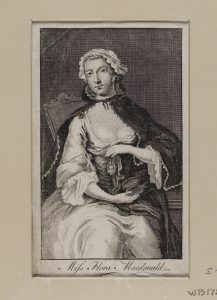Two Months in the Royal Archives, May-June 2017
 By Flora Fraser, GPP Fellow, Researcher and Author
By Flora Fraser, GPP Fellow, Researcher and Author
Memories of past years I spent researching books in the Royal Archives are crystal clear. I first went in autumn, just before the end of October 1988, when I was to be thirty. I was awed to be climbing the many stone steps inside William the Conqueror’s Round Tower at Windsor Castle, where the archives are housed. Generations of Royal biographers I admired – James Pope-Hennessy and indeed my grandmother, Elizabeth Longford – had preceded me.
In order to research a biography of Queen Caroline, George IV’s wife. I had been granted a term in the Archives of six months. In the event, I took rather longer to make sense of all twenty-nine boxes of the Queen’s papers. The Unruly Queen: The Life of Queen Caroline was ultimately published in 1996. By that time I was already hard at work once more in the Archives. Princesses: The Six Daughters of George III – and of Queen Charlotte – was published in 2004.

Portrait of the Washington Family by Edward Savage (1761-1817) (Sourced: Wikimedia, Public Domain)
My next biographies – Venus of Empire: A Life of Pauline Bonaparte (2009) and The Washingtons: George & Martha (2015) – led me, first, across the Channel and, then, across the Atlantic. But my affection for the Georgian and other Papers in the Royal Archives was undimmed. I browsed with pleasure Queen Victoria’s digitized journal, when it went live on the Royal Collection website in 2012, to mark our Queen s Golden Jubilee. And there are a few electrifying moments in one’s research and writing career. One such was when I learnt last autumn of the Georgian Papers Project, and of the imaginative partnering of the Royal Archives with King’s College, London, and, in the US, with the Omohundro Institute, the Library of Congress, the Sons of the American Revolution, and Mount Vernon.
When I was writing about George and Martha Washington’s marriage, I consulted the PGWDE – the digital edition of the first American President’s papers and the brainchild of Mount Vernon and the University of Virginia – remotely and daily in London for six years. So I appreciate just what a treasure trove – a bonanza! – digitized papers, copiously and expertly annotated, can be for a biographer. And now there is the Georgian Papers Project – a new bonanza for authors, academics, and the world beyond. Avenues of study and exploration online will multiply as the Project proceeds. I was delighted, early this year, to be chosen as the 2017 Mount Vernon Georgian Papers Fellow to research, the Royal Archives and in archives in the US, two book projects: a life of Flora Macdonald, the Scottish heroine who later emigrated to North Carolina and became caught up in the American Revolution; and a life of Nelson on shore and at sea.

Flora Macdonald (1722-1790); Jacobite Heroine 5 1/2 x 3 3/8 in. Portrait of Flora Macdonald seated, holding a miniature of Prince Charles on a ribbon. (Sourced: Wikimedia, Public Domain)
For my biography of Flora Macdonald, I explored, at Windsor, the Stuart Papers and the Cumberland Papers. The former are the – largely 18thC – papers of the exiled House of Stuart, including those of ‘Bonnie Prince Charlie’, Charles Edward Stuart. In the summer of 1746, having failed with a rebel army, including many Highland Scots, to restore the Stuart monarchy, the Prince was in hiding from Hanoverian troops in Hebridean islands off the west coast of Scotland. Flora, a young local girl, was of vital aid to Charles Edward in South Uist and Skye. The latter are the military papers of William Augustus, Duke of Cumberland, second son of George II, who was commander-in-chief in Scotland and directing the search for the Prince. I found rich pickings in both Stuart and Cumberland Papers for Flora’s heady week with the Prince in the Hebrides and for her subsequent capture and transportation to London for trial.
For my future biography of Nelson, meanwhile, I looked at a variety of papers in the Royal Archives. Some date from the Revolutionary War in America, where he served as a young naval officer. He provided advice and a degree of companionship to Prince William, later Duke of Clarence and William IV, during that young man’s brief career at sea. Others emanate from the Napoleonic Wars, in which conflict, as a much decorated admiral, Nelson died, victorious, in 1805 at the Battle of Trafalgar.
Many in the Royal Archives helped to make my research there so productive this May and June. Dr Oliver Walton corresponded with me helpfully in advance of my visit, answered further queries speedily, and gave interesting advice on the Georgian navy. Allison Derrett, an old friend in the Archives, was always ready to share expert advice. Roberta Giubilini, having worked on the Stuart and Cumberland Papers and being at work on the William IV papers, was interested in my two projects and a mine of information about specific boxes. Moreover, the bookshelves in the researchers’ room hold many useful books and published correspondence relevant to Georgian and later Royal history, which I consulted frequently. I am grateful, besides, to all those members of the Archives who hefted into the researchers’ room hundreds of volumes of Stuart Papers and many boxes of Cumberland Papers boxes. Last but not least, I owe much to Lynnette Beech, who kindly scanned documents for me, when I wanted more than pencilled notes and memory to recall them to mind.
May and June 2017 saw extremes of British weather and a stormy General Election. Closeted up in the sky, I never switched my mobile on and generally caught up with the day’s news on the train back to London. But some news permeated the Round Tower’s thick walls. These months also saw extremist attacks in Manchester and London. We stood for an inadequate but sincere minute’s silence twice in two months in the Archives.
Windsor Castle is an idiosyncratic place. A Governor, Poor Knights and the clergy of St George’s Chapel, besides the Royal Family, are just some of its many residents. This has been the case since the days of George III and Queen Charlotte and of many earlier monarchs. The unchanging nature of much about Windsor has its effect. As I walked to up through the Castle to the Archives this summer, I sometimes felt as if I were my younger self and researching there thirty years ago. Up, as ever, I strolled from Henry VIII Gate, and through Lower Ward, looking idly at the Round Tower on the skyline ahead to see if the Queen was in residence. When Court is at Windsor, the Royal standard flies, yellow and red lions streaming in the wind. Up again, as ever, I proceeded, past the Moat Garden, beautifully planted, and now my pace quickened. The door at the base of the Round Tower gives onto that steep ascent inside to the Archives and to WORK. The same impetus to have at the papers made me bound up the steps this summer with quite as much energy as in 1988.
There is the odd diversion in the Archives not usually to be had in muniment rooms, and new to me, since a renovation of the Archives, and change in function of several rooms there. When Court is at Windsor a band marches midmorning into Upper Ward, to serenade the monarch. The music floats crystal clear up to the new researchers’ room in the Round Tower. ‘Not Coldplay again …’, one of our number muttered absent-mindedly on one occasion. Another researcher looked up and said, ‘The Queen likes them. Prince Harry got her into them’.
Apart from these occasional musical intervals, the quiet of the large researchers’ room is little disturbed. In company with others, I leafed through boxes of papers, squinted at handwriting, and transcribed letters in part or in full. Some pecked at computers. Others, like I, were pencil and paper devotees. Once the Lord Chamberlain came in unexpectedly to enquire about the scope of our research. Returning from the depths of the mid 18th c, I attempted and failed to give a coherent answer.
I was fortunate enough to be in the Archives also when Dr Carla Hayden, the new Librarian of Congress, and some of her colleagues visited from DC. I consulted the Library’s digital collections at loc.gov extensively when writing about the Washingtons, and the new partnership between the Royal Archives and the Library is exciting to contemplate. Additionally Dr Hayden told me about a Georgian show in contemplation at the Library. She suggested that, when I was on my Fellowship at Mount Vernon in October, I should talk to the exhibition team. Atlantic Studies, rule OK!
I am grateful to many who offered me help before, during and after my time in the Archives. Bruce Ragsdale, my distinguished predecessor as Mount Vernon Georgian Papers Fellow, offered sound practical advice about working at the Royal Archives. Doug Bradburn and Stephen McLeod, Founding Director and Director of Library programs at the George Washington Library, Mount Vernon, respectively, were strong in support. Arthur Burns at King’s and Karin Wulf at the Omohundro are inspiring and enthusiastic academic leaders. Who, besides, would not enjoy discussing Nelson with Laughton Professor of Naval History, Andrew Lambert, as I did, when presenting research at King’s in June?
Most of all, I love the cross-disciplinary connections that are growing up around the GPP. Together, Fellows and institutions from both sides of the Atlantic are considering 18th c politics, warfare, agriculture, trade, material culture and much else. I lose track, besides, of the number of cups of tea and drinks and meals I have shared with new friends made, since I became a Georgian Papers Fellow.
My two months at the Royal Archives this summer are still inchoate and unprocessed. No doubt with time the narrative will sharpen. However, even at this stage, I am aware that my research at Windsor has fleshed out greatly for me the part Flora Macdonald played in the Forty-Five. In the case of Nelson, the Georgian papers have made me think hard about both his character and his social standing at different times of his truncated life. But that’s for the future. Now to write Flora! Or even, now to write, Flora …
